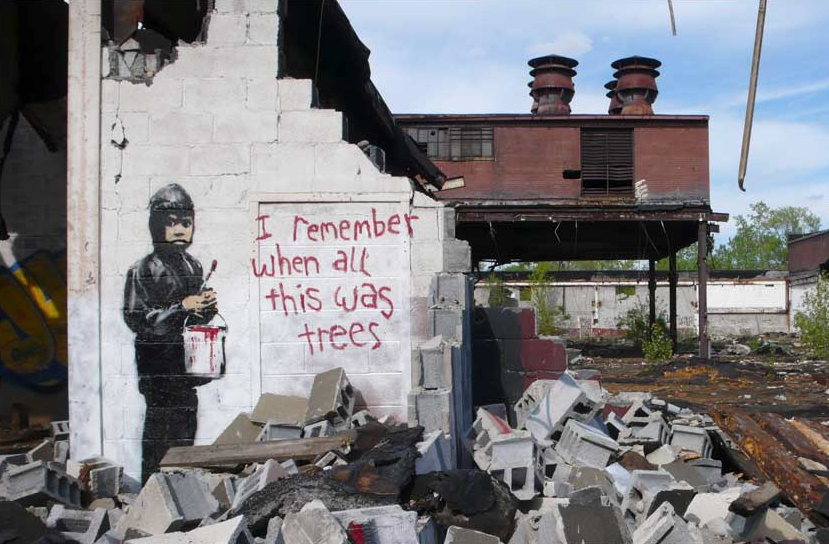If I sneak into your yard and paint a picture on your wall, do you now own my painting? Or, as the artist, do I retain ownership of the painting and its context?
What if I paint the picture on seemingly abandoned property? Does the bank now own it? The municipality? What if you like it so much that you decide to cut the art out of the wall — to protect it, of course — and move it to your gallery? Have you just become an art thief? And, if so, did you steal from the property owner, or the original artist?
These questions, and more, are playing out in Detroit, where famed street artist Banksy recently splashed his overnight guerrilla art on the crumbling wall of a shuttered factory. The art was promptly rescued from the scene by a “feisty grassroots group” of artists connected with an art gallery, who preserved it by sawing it out of the wall and trucking it to their gallery where, presumably, it now stands preserved like a piece of that other Wall that once bisected Berlin.
I have to admit that Banksy has been, at best, a slow burn for me, and I have very real concerns about art that appears on private property without permission, but there’s no question that his current cross-country-America meanderings have been entertaining and have had the beneficial side effect of opening up discussions about art in the public sphere. For instance, in this case, if an artist creates a work specific to a place — ignoring its legality for the moment — isn’t it better to leave it there, where it speaks for itself, rather than move it to a room with hardwood floors and refrigerated air, where a small, tasteful card explains exactly what “all this” refers to?
As is often the case, the most astute commentary — from both sides — can be found on the inevitable Metafilter thread about the art heist:
“This can only legally be described as one thing: Theft of a wall on which an act of vandalism has been committed.
“I love Banksy’s stuff – it’s everything art should be. It’s interesting, relevant, controversial, and it’s highly visible. It’s accessible. Is it supposed to be permanent? Of course not.
“However, I also agree that it’s obviously vandalism. It’s part of the discomfort that makes his stuff so interesting. Is the act of vandalism more accepted because of the works? Is it more valuable because he’s famous? Is it more relevant because it’s discussed? When does it cross the line?
“There are no right and wrong answers to these questions – only legal ramifications. But when something is in the public realm, and it’s not your property, you have no right to take it. As soon as 555 did that, they ruined the piece.”



 Tattoo says
Tattoo says
May 27, 2010 at 8:32 amBanksy is a great artist and when I was visiting London last year Ive seen some of his street art. I have to admit that hes has a great Ideas for all those graffiti and the message that comes from his art is very deep. I also heard that some of the properties marked with the Banksy paintings are much expensive than they were before Banksy left his mark on them. Some people say that this is just a vandalism but I don't think so and the world need such artist like Banksy.
 Tattoo says
Tattoo says
May 27, 2010 at 1:32 pmBanksy is a great artist and when I was visiting London last year Ive seen some of his street art. I have to admit that hes has a great Ideas for all those graffiti and the message that comes from his art is very deep. I also heard that some of the properties marked with the Banksy paintings are much expensive than they were before Banksy left his mark on them. Some people say that this is just a vandalism but I don't think so and the world need such artist like Banksy.